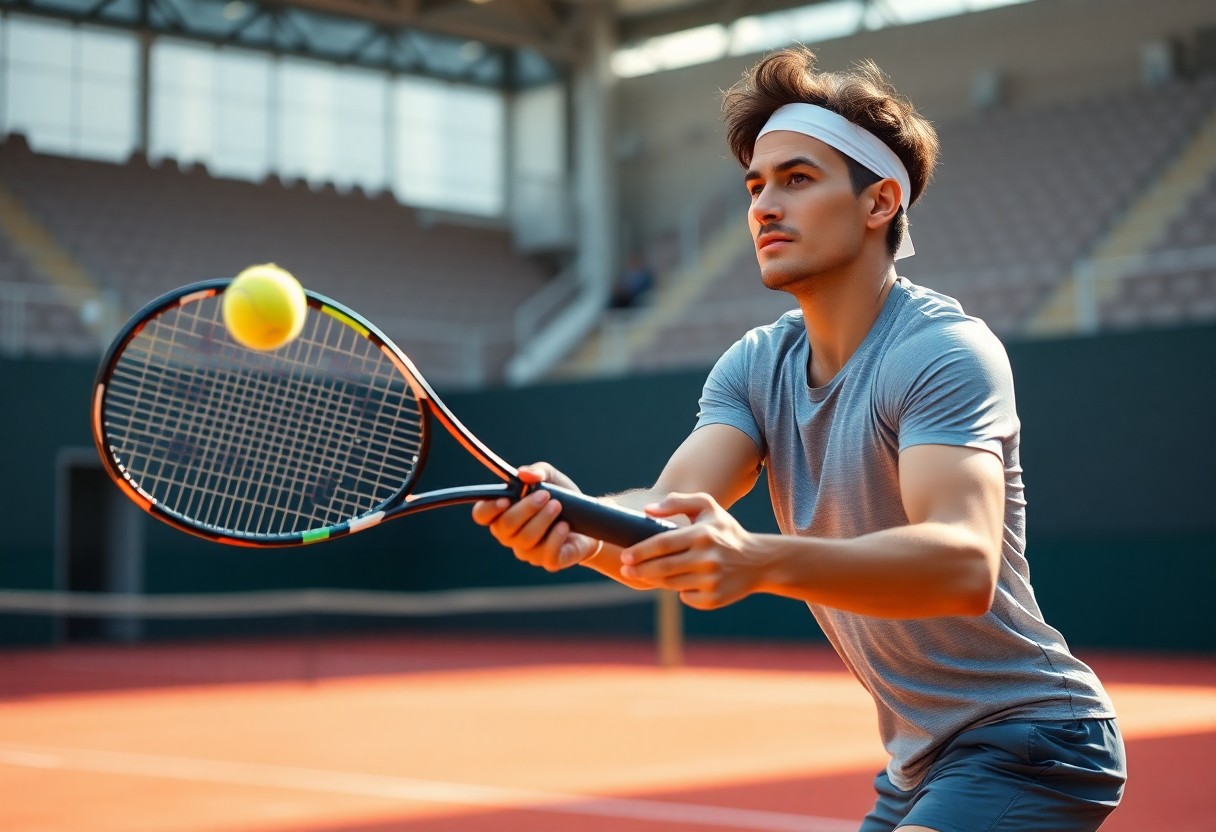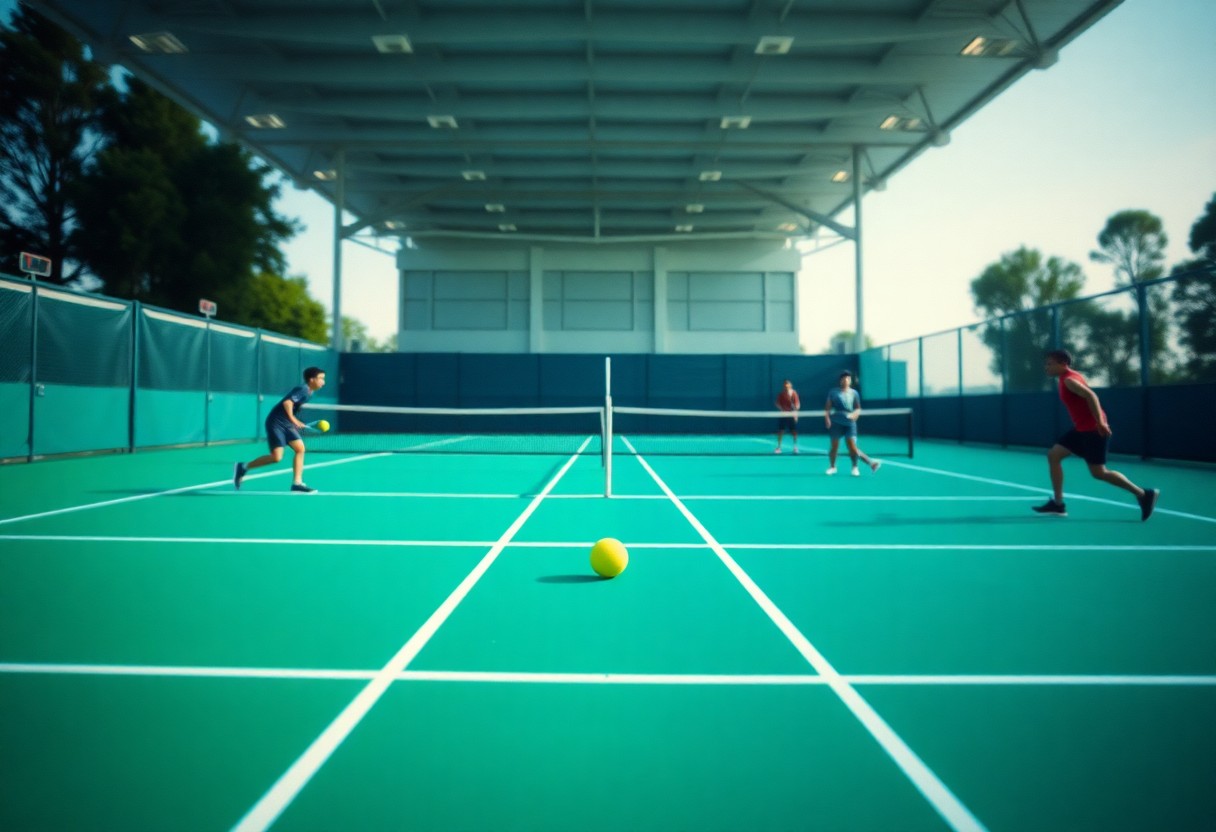Most players underestimate the importance of adapting their tactics to various court surfaces, which can significantly impact performance. On hard courts, a blend of power and precision typically prevails, while clay courts favor strategic baseline rallies and endurance. In contrast, grass courts demand quick reflexes and a strong volleying game due to the faster ball speed and unpredictable bounces. By understanding these key differences, players can enhance their gameplay and capitalize on their strengths, ensuring they’re prepared for any match scenario.
Types of Court Surfaces
Tennis is played on various surfaces, each affecting gameplay and strategy significantly. Understanding these surfaces enhances player adaptability and performance. Key surfaces include:
- Hard Courts
- Clay Courts
- Grass Courts
- Artificial Grass
- Carpet Courts
This foundational knowledge is vital for tailoring tactics to maximize success.
Hard Courts
Hard courts are known for their quick bounce and consistent playing conditions. Players must rely on strong baseline play and quick footwork to maneuver effectively. Generally, hard courts favor aggressive players who can take control of points.
Clay Courts
Clay courts offer slower play and higher bounces, requiring patience and strategic shot placement. The softer surface allows for longer rallies, rewarding players with endurance and tactical finesse.
Players often adopt a more defensive strategy on clay, using spins and placement to wear down opponents. The surface favors those who can construct points and utilize drop shots or lobs effectively. Matches can extend in length due to the demanding nature of clay, challenging both physicality and mental resilience.
Grass Courts
Grass courts are characterized by their fast pace and low bounce, demanding quick reflexes and net play skills. The surface generally benefits serve-and-volley players, enabling strong serving strategies.
Grass courts can yield unpredictable bounces, requiring players to adjust rapidly. This makes agility and precision important. The unique challenges of grass favor those who excel in short, aggressive exchanges and maintain an offensive mindset throughout the match.
Key Factors Influencing Strategy
- Ball speed
- Bounce height
- Court surface texture
Any adjustment to your tennis tactics must account for these key factors that influence performance.
Ball Speed
Ball speed is directly linked to the type of court surface being played on. For instance, hard courts typically produce faster ball speeds compared to clay, which slows down the ball due to its gritty nature. Adjusting your shots and positioning based on how quickly the ball travels is crucial for effective play.
Bounce Height
Bounce height varies significantly across surfaces, influencing shot selection and strategy. On grass courts, the ball tends to stay low, requiring players to adapt by utilizing flatter strokes and quick reactions. In contrast, clay courts provide a higher bounce, encouraging longer rallies and spin-heavy shots.
The variation is particularly noticeable when considering professional play; for example, the average bounce height on clay can be 10-12 inches, while on grass, it can be less than 4 inches. These differences dictate whether to employ aggressive net approaches or deeper baseline rallies based on the surface underfoot.
Court Surface Texture
Court surface texture plays a vital role in influencing grip and control. For example, a rough clay surface allows for greater spin potential, enabling topspin shots to engage effectively. In contrast, smooth hardwood makes sliding to alter position difficult, calling for different ankle stability and footwork strategies.
Players must also consider how texture affects durability and wear on their shoes; textured surfaces can wear out soles faster, requiring more frequent replacements. Understanding these elements ensures players not only perform optimally but also stay injury-free during matches.
Tips for Adjusting Your Game
Adapting your game to different surfaces requires an understanding of their unique characteristics. Consider the following tips:
- Focus on court speed; faster surfaces benefit aggressive play.
- Adjust your footwork; clay demands more lateral movement.
- Alter your shot selection; flatter shots work better on hard courts.
- Practice your serve; spin serves excel on clay, while hard courts favor flat serves.
Assume that each surface showcases your strengths and weaknesses differently, so practice specific strategies accordingly.
Serving Strategies
Your serving strategy should vary with the surface texture. On hard courts, prioritize flat serves for speed, while on clay, employ more topspin to control the ball and create a higher bounce. Adjust your placement based on the opponent’s positioning, using kick serves effectively to exploit their weaknesses.
Baseline Play
Baseline play shifts distinctly across surfaces. On hard courts, a potent mix of depth and pace can keep opponents on the defensive. In contrast, clay courts demand a focus on consistency and patience, utilizing high topspin shots to maintain rallies. Adjusting your grip and swing will enhance control over your shots.
Furthermore, on clay courts, baseline players might encounter longer rallies due to the surface’s slower nature. Adapting your strategy involves incorporating angle shots to open up the court while also preparing for higher bounces. Establishing a solid follow-through and utilizing body positioning will ensure more effective power and placement, ultimately dictating the pace of the game.
Net Approach
When approaching the net, surface variation influences your strategy significantly. Fast surfaces like grass demand quick reflexes and precise volleying techniques, while slower clay courts provide more time to set up your approach. Therefore, transitioning effectively from baseline to net becomes imperative; reliable footwork and excellent anticipation are vital for success.
On grass, utilize aggressive net play to capitalize on quick points, whereas on clay, work on constructing points first before advancing. Awareness of opponent positioning is key; a smart approach can lead to winning volleys. Additionally, refining your overhead shots allows for confident play when closing in, keeping your opponent guessing and on the back foot.
Step-by-Step Strategy Adjustments
| Surface Type | Strategy Adjustments |
| Clay | Utilize heavy topspin and patient rallies. |
| Grass | Incorporate serve-and-volley tactics and quick points. |
| Hard | Focus on all-court play and powerful groundstrokes. |
Pre-Match Preparation
Before a match, assess the court surface to tailor your practice. Use drills that simulate the match conditions you’ll face, emphasizing your primary shot strengths and favorite playing styles. Prepare physically and mentally for the specific demands of the surface, such as enhancing your agility on clay or improving your reaction time on grass.
In-Match Tactics
Adapting your strategy during the match is important. Monitor your opponent’s weaknesses actively and adjust your shot selection accordingly. On slower surfaces, aim for longer rallies to extract errors, while on faster surfaces, seek aggressive angles to finish points swiftly.
For example, on clay courts, aim for deep, high-bouncing shots to push your opponent back, while using drop shots sparingly. Conversely, on grass, focus on low, fast returns that limit your opponent’s reaction time. Identify patterns to exploit; if your opponent struggles with backhand returns, target that area consistently. By continuously assessing their responses, you can stay one step ahead.
Post-Match Analysis
After the match, take time to review your performance critically. Analyze key moments, including your shot selections and any lapses in execution. Make notes on how the surface influenced the match flow, and identify adjustments for future encounters. This reflection helps build a strategic foundation for your next match.
Using video analysis can be particularly effective; watching your match can reveal underlying patterns and areas needing improvement. Pay attention to your movement and shot placement relative to the court surface. Engaging in this reflective practice not only reinforces learning but also strategically enhances future performance on various surfaces.
Pros and Cons of Each Surface
| Surface | Pros and Cons |
|---|---|
| Hard Courts | Fast play; durable surface. Can lead to injuries due to hardness. |
| Clay Courts | Excellent for baseline rallies; slower pace. Difficult for aggressive players. |
| Grass Courts | Fast and low bouncing; promotes serve-and-volley. Weather-dependent; maintenance-intensive. |
| Indoor Hard Courts | Consistent playing conditions; less affected by weather. Limited visibility if poorly lit. |
| Artificial Grass | Durable and less maintenance; mimics grass. Can cause slips if not cared for properly. |
| Carpet Courts | Fast play; easy to install. Less common; fabrics can wear out quickly. |
| Red Clay | High traction; allows for longer rallies. Harder to move quickly due to dirt. |
| Green Clay | Similar to red clay but faster. Fairly slippery; less traction. |
| Natural Grass | Unique playing experience; quick points. Limited playing season; inconsistent bounces. |
| Rebound Ace | Good shock absorption; promotes baseline play. Often less durable compared to hard courts. |
Hard Courts
Hard courts provide a consistent and fast-playing surface that benefits players with strong serves and powerful baseline shots. The surface’s durability allows for year-round play, making it a popular choice worldwide. However, the hardness can lead to increased risk of injury, particularly to joints.
Clay Courts
Clay courts slow down the ball and produce a higher bounce, favoring players who excel in strategic, baseline rallies. These courts enhance defensive play and require patience, but they can be challenging for those who rely on quick points or aggressive net play.
Players often find themselves engaged in longer rallies on clay, as the surface allows for more time to react. The slower conditions test endurance and consistency, rewarding those who can outlast opponents. Notably, clay requires an adjustment in footwork and slide techniques, making it vital for players to adapt their strategy accordingly.
Grass Courts
Grass courts promote an incredibly fast-paced game where serve-and-volley tactics shine due to the low bounce of the ball. This surface tests a player’s ability to adjust quickly, favoring those with strong serves and sharp net play.
Grass courts, however, demand careful maintenance and can be affected by weather conditions, making them less predictable. The unique bounce and surface texture require players to adapt their footwork and shot selection, as the grass can change the ball’s behavior from day to day. Mastery of this surface often separates elite players from the rest of the field during tournaments like Wimbledon.
To wrap up
Drawing together the nuances of adjusting your tennis strategy based on court surfaces highlights the importance of flexibility in play. On grass, prioritize serve-and-volley tactics due to faster conditions; on clay, employ consistent baseline rallies to exploit slower balls. Hard courts require a balanced approach, integrating both styles. Understanding these surface dynamics enhances adaptability, allowing players to leverage their strengths effectively. Embracing these adjustments not only boosts performance but also deepens one’s appreciation for the game’s diverse challenges.
FAQ
Q: How does playing on clay courts affect my tennis strategy?
A: On clay courts, points tend to be longer due to the slower surface. Players should focus on consistency and constructing points carefully, utilizing topspin and strategic placement. Transitioning to the net can be less effective, so baseline rallies and patience are key.
Q: What adjustments should I make for grass court play?
A: Grass courts favor a faster game with lower bounces. Players should prioritize serve and volley tactics, focusing on aggressive play and quick points. It’s important to capitalize on opportunities to go to the net and exploit any weak returns from opponents.
Q: How does my strategy change on hard courts?
A: Hard courts provide a balance between speed and bounce, allowing a mix of strategies. Players should adjust between baseline power shots and net approaches, depending on the opponent’s weaknesses. Solid serving and effective returning are important for gaining an advantage.




